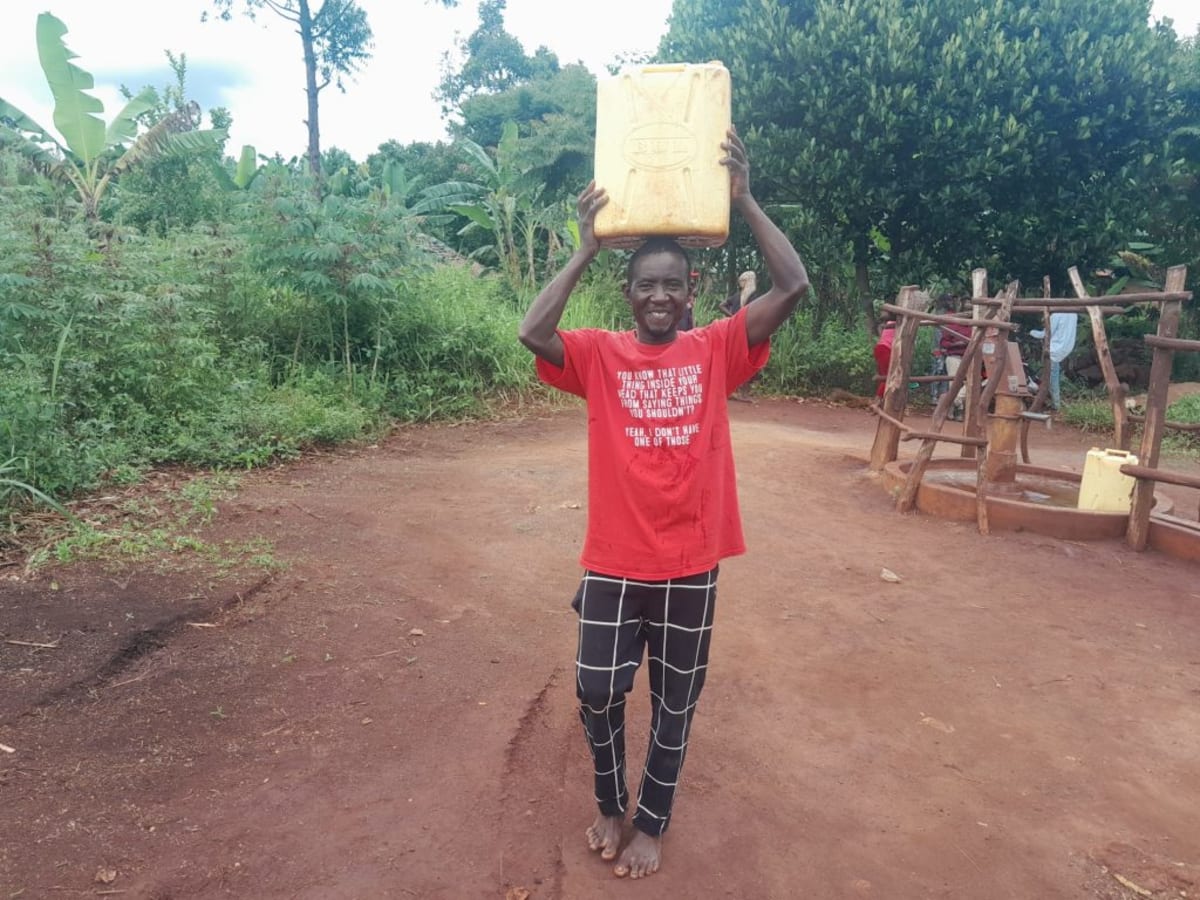Every day, the 520 people of Karungu have to walk incredibly long distances, some up to 3 km (1.86 miles), to reach water. They must trek through forests and sugarcane plantations, which are well-known haunts of poisonous snakes, or send their children alone, which presents other dangers.

"My challenge is walking the long distance to collect about three to four jerrycans of water in a day. Rarely do I borrow a neighbor's bicycle to use," said 30-year-old Scovia, shown in the photo above. Tragically, in the photo, she is walking past a defunct well on her way to an open, unprotected surface water source.
Scovia told us that her husband has a drinking problem, which leaves her in an unfortunate situation for multiple reasons. As a mother of four children, time wasted at the water point means she must put less effort into her farm. Therefore, she makes less money and can't provide sufficient or timely meals for her family.
Similarly, 14-year-old Peter (shown in the photo below, fetching water next to Scovia) can't ever seem to get everything done in a day. "I go to school early morning at 6:30 a.m., moving about two km (1.24 miles) away, since I have to be in class by 7:30 a.m. This sometimes forces me to go running because I have to be in class on time to avoid being beaten."

"After school, I arrive home by 5:00 p.m. and rush to collect water as I have to clean my uniforms and do homework," Peter continued. "Because of the long distance I move to the water source, I get very tired and reach home late. Due to lack of power (energy), I fail to do my homework in time, and am always beaten at school."
And after all the effort required to obtain it, the untreated water makes Karungu's people—especially its children—sick. The most common complaints are typhoid, cholera, skin rashes, and malaria.
With a new centrally located borehole well, Scovia and Peter will have more time and energy to accomplish their daily tasks. They and their loved ones will suffer less from water-related illness. With improved health and more time, who knows what they could accomplish?
Here’s what we’re going to do about it:
New Borehole
This new borehole is an exciting opportunity for this community! We work with the community to determine the best possible sites for this well.
We conducted a hydrogeological survey and the results indicated the water table is an ideal candidate for a borehole well. Due to a borehole well's unique ability to tap into a safe, year-round water column, it will be poised to serve all of the water needs for this community, even through the dry months.
Community members will help collect the needed construction materials such as sand, rocks, and water for mixing cement. They will also provide housing and meals for the work team, in addition to providing local laborers. We will complement their materials by providing an expert team of artisans and drilling professionals, tools, hardware, and the hand-pump. Once finished, water from the well will then be used by community members for drinking, handwashing, cooking, cleaning, and much more.
Training
Training’s main objectives are the use of latrines and observing proper hygiene practices since these goals are inherently connected to the provision of clean water. Open defecation, water storage in unclean containers and the absence of hand-washing are all possible contaminants of a household water supply. Each participating village must achieve Open Defecation Free status (defined by one latrine per household) prior to the pump installation for this borehole well.
This social program includes the assignment of one Community Development Officer (CDO) to each village. The CDO encourages each household to build an ideal homestead that includes: a latrine, a handwashing facility, a separate structure for animals, a rubbish pit and a drying rack for dishes.
We also implement the Community-Led Total Sanitation (CLTS) approach with each of our village partners. This aims to improve the sanitation and hygiene practices and behaviors of a village. During these sessions, village leaders naturally emerge and push the community to realize that the current practices of individual households – particularly the practice of open defecation – are not only unhealthy, but affect the entire village. CLTS facilitates a process in which community members realize the negative consequences of their current water, sanitation and hygiene behaviors and are inspired to take action. Group interactions are frequent motivators for individual households to build latrines, use them, and demand that other households do the same.
Improved Sanitation
The aim is that all households own an improved latrine. Many households do not use a latrine but use the bush. Due to open defecation, feces are spread all over the village. This leads to waterborne diseases and contamination of groundwater and surface water. Our aim is that the community is able to live a healthy life free of preventable diseases. We endeavor that at the end of our presence in the community, people will have both access to sustainable, clean water and access to sanitation. We have now organized families to form digging groups for latrine construction, and empowered them with tools to use.

 Borehole Well and Hand Pump
Borehole Well and Hand Pump
 Rehabilitation Project
Rehabilitation Project


























